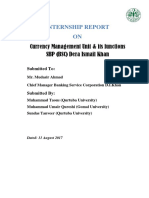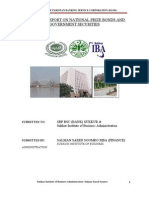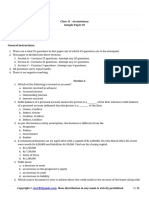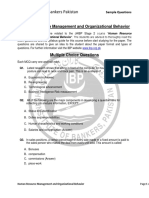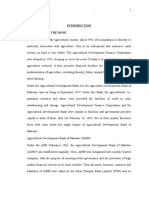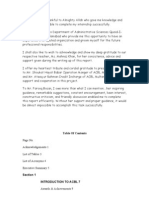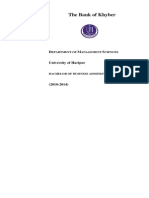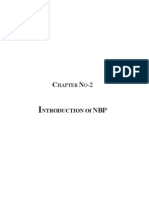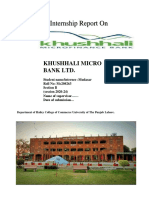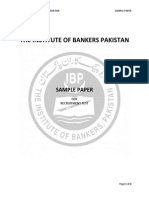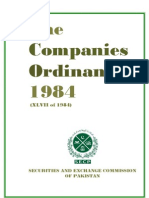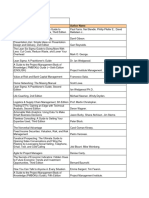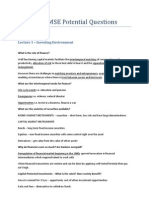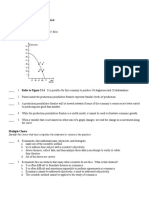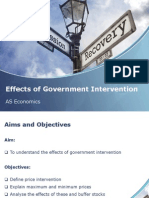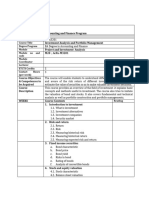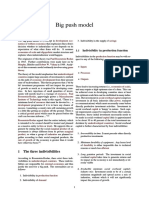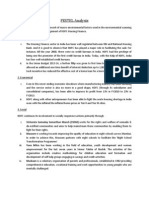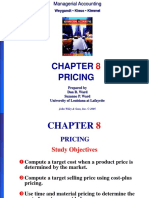SamplePaper (OG 2 YPIP 5thbatch)
SamplePaper (OG 2 YPIP 5thbatch)
Uploaded by
Jitesh MaheshwariCopyright:
Available Formats
SamplePaper (OG 2 YPIP 5thbatch)
SamplePaper (OG 2 YPIP 5thbatch)
Uploaded by
Jitesh MaheshwariOriginal Description:
Original Title
Copyright
Available Formats
Share this document
Did you find this document useful?
Is this content inappropriate?
Copyright:
Available Formats
SamplePaper (OG 2 YPIP 5thbatch)
SamplePaper (OG 2 YPIP 5thbatch)
Uploaded by
Jitesh MaheshwariCopyright:
Available Formats
THE INSTITUTE OF BANKERS PAKISTAN
SAMPLE PAPER
THE INSTITUTE OF BANKERS PAKISTAN
SAMPLE PAPER
FOR
RECRUITMENT TEST
Page 1 of 6
THE INSTITUTE OF BANKERS PAKISTAN
SAMPLE PAPER
ENGLISH COMPOSITION
Read the passage carefully and answer questions 1-3
Most large corporations in the Country B were once run by individual capitalists who owned
enough stock to dominate the board of directors and dictate company policy. Because putting
such large amounts of stock on the market would only depress its value, they could not sell out
for a quick profit and instead had to concentrate on improving the long-term productivity of their
companies. Today, with few exceptions, the stock of large Country B corporations is held by
large institutions pension funds, for example and because these institutions are prohibited
by antitrust laws from owning a majority of a companys stock and from actively influencing a
companys decision-making, they can enhance their wealth only by buying and selling stock in
anticipation of fluctuations in its value. A minority shareholder is necessarily a short-term trader.
As a result, Country B productivity is unlikely to improve unless shareholders and the managers
of the companies in which they invest are encouraged to enhance long-term productivity (and
hence long-term profitability), rather than simply to maximize short-term profits.
Q1.
In the passage, the author is primarily concerned with
A.
B.
C.
D.
Q2.
Regarding business controlled by individual capitalists, the author assumes that
A.
B.
C.
D.
Q3.
each business had only a few stockholders.
institutions owned no stock in these companies.
improving long-term productivity led to increased profits.
these businesses were less profitable than the businesses today.
The method left for institutions to increase their wealth due to antitrust laws is by
A.
B.
C.
D.
Q4.
comparing two different approaches to a problem.
describing a problem and proposing a solution.
defending an established method.
presenting data and drawing conclusions from the data.
trading stocks.
increasing investment.
establishing a joint venture.
buy all stocks of a company.
The elderly professor was often seen sitting and thinking. I imagine, he was ______ his
long academic career.
A.
B.
C.
D.
reflecting on
engaging in
comprehending
planning
Page 2 of 6
THE INSTITUTE OF BANKERS PAKISTAN
Q5.
SAMPLE PAPER
A customer relationship manager wrote the following line in a letter to the customer:
In my opinion, you should purchase the gold card
The sentence contains which of the following tone?
A.
B.
C.
D.
Q6.
Appropriateness
Confidence
Sincerity
Subjectivity
The new measures taken by the manager have made a big difference at work. The
manager has been a
A.
B.
C.
D.
forced for good.
force of good.
force for good.
forced good.
QUANTITATIVE SKILLS & GENERAL INTELLIGENCE
Q7.
Consider two sets:
A { 5, 7, 9, 11 } B { 2, 6, 10, 16, 18 }
What will be the probability if the sum of two numbers, one picked up from set A and the
other from set B are 25?
A.
B.
C.
D.
0.05
0.10
0.25
0.30
Solution:
Each of the integers in the first set could be combined with any number from the second set,
giving a total of 4 x 5 = 20 possible pairs. Of these, the combinations that could give a sum of 25
are (7 + 18), and (9 + 16). This means that the probability of getting a sum of 25 is 2/20 = 1/10 =
0.10
Page 3 of 6
THE INSTITUTE OF BANKERS PAKISTAN
SAMPLE PAPER
Q8.
Identify the missing picture.
Q9.
A car traveled 75% of the way from town A to town B at an average speed of 50 mph. The
car travels at an average speed of S mph for the remaining part of the trip. The average
speed for the entire trip was 40mph. The value of S is
A.
B.
C.
D.
10
20
25
30
Solution:
50(0.75) + S(0.25) = 40 => 0.25S = 40 37.5 => S = 10;
Q10. The price of commodity A is Rs 8,000 and it increases at the rate of Rs 7 per six months.
Commodity B costs Rs 7,500 and it increases at the rate of Rs 8 per three months. The
number of years it will take for the two commodities to become equal in price is:
A.
B.
C.
D.
4.5
3.8
50
60
Solution
Total price increase of A in a year would be: 7 x 2 = Rs. 14
Total price increase of B in a year would be: 8 x 4 = Rs. 24
Since we need to calculate when they become equal, we can write the equation as:
8000 + 14x = 7500 + 24x => x = 50
Page 4 of 6
THE INSTITUTE OF BANKERS PAKISTAN
SAMPLE PAPER
CURRENT AFFAIRS & PAK ECONOMY
Q11. Which of the following is NOT considered a cash crop of Pakistan?
A.
B.
C.
D.
Cotton
Maize
Sugar Cane
Barley
Q12. The shareholders of a limited company are referred to in Company Law as
A.
B.
C.
D.
Promoters.
Members.
Directors.
Creditors.
Q13. Which companies shares are traded at Stock Exchange?
A.
B.
C.
D.
Private Limited Companies
Un-listed Public Limited Companies
Listed Public Limited Companies
Companies Limited by guarantee
Q14. The recent Cantonment Board Local Bodies Election was held in the country after
A. 7 years.
B. 11 years.
C. 14 years.
D. 17 years.
X --- END OF PAPER --- X
Page 5 of 6
THE INSTITUTE OF BANKERS PAKISTAN
SAMPLE PAPER
ANSWERS
Question
Number
1
2
3
4
5
6
7
8
9
10
11
12
13
14
Key
B
C
A
A
D
C
B
A
A
C
D
B
C
D
Page 6 of 6
You might also like
- ASAL Business Workbook Answers PDFDocument112 pagesASAL Business Workbook Answers PDFnajla nisthar100% (1)
- Financial Markets and Institutions 8th Edition Mishkin Eakins Solutions Manual Instant DownloadDocument6 pagesFinancial Markets and Institutions 8th Edition Mishkin Eakins Solutions Manual Instant DownloadEng Abdikarim WalhadNo ratings yet
- SBP SBOTS (OG-2) 22nd Batch Test PDFDocument1 pageSBP SBOTS (OG-2) 22nd Batch Test PDFMuneeb AnsariNo ratings yet
- Mid Term FNCE 2020Document13 pagesMid Term FNCE 2020MOHAMED JALEEL MOHAMED SIDDEEKNo ratings yet
- Awais DaoDocument68 pagesAwais DaoFaisal AwanNo ratings yet
- Positioning Statement: Target AudienceDocument4 pagesPositioning Statement: Target AudienceJitesh Maheshwari100% (1)
- Microeconomics Chapter 2Document15 pagesMicroeconomics Chapter 2Ian Jowmariell GonzalesNo ratings yet
- Peter Bernholz - Monetary Regimes and Inflation: History, Economic and Political Relationships (2003)Document225 pagesPeter Bernholz - Monetary Regimes and Inflation: History, Economic and Political Relationships (2003)1236howard100% (1)
- The Institute of Bankers Pakistan: Sample PaperDocument5 pagesThe Institute of Bankers Pakistan: Sample PaperkoolyarNo ratings yet
- Sample Paper OG2 YPIP 5th BatchDocument6 pagesSample Paper OG2 YPIP 5th BatchAhmad Nauman0% (3)
- Internship Report SBP OriginalpdfDocument33 pagesInternship Report SBP OriginalpdfUmair QureshiNo ratings yet
- Report On Prize Bonds and Other Unit of SBP BSC (Bank) SukkurDocument33 pagesReport On Prize Bonds and Other Unit of SBP BSC (Bank) Sukkursalman saeed80% (5)
- Sample Paper IBPDocument4 pagesSample Paper IBPMuhammad RamzanNo ratings yet
- Introduction To Financial Systems and Banking Regulations: Institute of Bankers PakistanDocument3 pagesIntroduction To Financial Systems and Banking Regulations: Institute of Bankers PakistanUmar AwanNo ratings yet
- HRM Case Test 1 PDFDocument5 pagesHRM Case Test 1 PDFVinodshankar BhatNo ratings yet
- PPCBL Sample PaperDocument6 pagesPPCBL Sample Papertalhach624No ratings yet
- Marketing Management: A Case Study of National Bank of Pakistan (NBP)Document38 pagesMarketing Management: A Case Study of National Bank of Pakistan (NBP)babar2620% (1)
- Internship Report SBP PBUDocument13 pagesInternship Report SBP PBUanmol maryamNo ratings yet
- Introduction of MCB: IncorporationDocument11 pagesIntroduction of MCB: IncorporationAli Jameel75% (4)
- Presentation SBPDocument21 pagesPresentation SBPlukykhan2000No ratings yet
- Business Communication For Financial Services: Institute of Bankers PakistanDocument6 pagesBusiness Communication For Financial Services: Institute of Bankers PakistanMuhammad Kashif100% (1)
- 11 Accountancy SP 1Document12 pages11 Accountancy SP 1Ujjwal Agrawal100% (1)
- Internship Report On State Bank BSC MultanDocument46 pagesInternship Report On State Bank BSC MultanAhmadSaleemAhmeiNo ratings yet
- Advertisement No. 16-2023 Accounts AssistantsDocument2 pagesAdvertisement No. 16-2023 Accounts AssistantsFarah AhmedNo ratings yet
- MCB IslamicDocument21 pagesMCB IslamicSadia ArslanNo ratings yet
- IFMP Pakistan's Market Regulations Certification Mock Examination (100 QS) PDFDocument32 pagesIFMP Pakistan's Market Regulations Certification Mock Examination (100 QS) PDFJackey911100% (1)
- MCB Internship ReportDocument31 pagesMCB Internship ReportShakeel QureshiNo ratings yet
- Institute of Bankers Pakistan: Human Resource Management and Organizational BehaviorDocument3 pagesInstitute of Bankers Pakistan: Human Resource Management and Organizational BehaviorMuhammad KashifNo ratings yet
- State Bank of PakistanDocument72 pagesState Bank of PakistanIlyas Ansari100% (2)
- Chap-4 Departmentalization of NBPDocument25 pagesChap-4 Departmentalization of NBP✬ SHANZA MALIK ✬No ratings yet
- Internship Report On MCB (PIA Society Branch) 2013 by Azka Sumbel, IBITDocument133 pagesInternship Report On MCB (PIA Society Branch) 2013 by Azka Sumbel, IBITAzka Sumbel QM IbNo ratings yet
- N.B.P FinalDocument47 pagesN.B.P Finalammar_acca100% (1)
- Following Are The Honda Atlas' Important Strengths, Weaknesses, Opportunities and ThreatsDocument3 pagesFollowing Are The Honda Atlas' Important Strengths, Weaknesses, Opportunities and ThreatsSaad Majeed100% (1)
- Numan Intership Final Report MCB2022Document23 pagesNuman Intership Final Report MCB2022Muhammad ImranNo ratings yet
- (Semi-III) - BFG 301 Final Sept 17Document176 pages(Semi-III) - BFG 301 Final Sept 17Mohsin ShaikhNo ratings yet
- INTERNSHIP REPORT ON MCB BANK LIMITED,,lastDocument84 pagesINTERNSHIP REPORT ON MCB BANK LIMITED,,lastHaris KhakwaniNo ratings yet
- NBP Presentation (Final)Document62 pagesNBP Presentation (Final)Mudassir Saeed0% (1)
- Internship Report On MCBDocument81 pagesInternship Report On MCBausaf ahmadNo ratings yet
- Aga Khan Education Service, Pakistan: Hamdard Institute of Management SciencesDocument24 pagesAga Khan Education Service, Pakistan: Hamdard Institute of Management SciencesRahim LakhaniNo ratings yet
- ZTBL 14.8.16Document68 pagesZTBL 14.8.16MansoorBalochNo ratings yet
- Askari Bank Internship ReportDocument42 pagesAskari Bank Internship ReportArslan AzeemNo ratings yet
- Meezan Bank Internship ReportDocument32 pagesMeezan Bank Internship ReportRanaAakashAhmadNo ratings yet
- NBP Final Report (S.M) ButtDocument28 pagesNBP Final Report (S.M) ButtFahad Khalid100% (1)
- Functions of National Saving OrganizationDocument42 pagesFunctions of National Saving OrganizationDebbie Jacobson62% (29)
- Banking in PakistanDocument2 pagesBanking in PakistanGhulam AbbasNo ratings yet
- Project Proposal: Akhuwat's Business Model: Fighting Poverty With Interest-Free MicrofinanceDocument7 pagesProject Proposal: Akhuwat's Business Model: Fighting Poverty With Interest-Free MicrofinanceTaiba e ShaheenNo ratings yet
- Bank of KhyberDocument48 pagesBank of KhyberSameer KhanNo ratings yet
- MCB Internship ReportDocument66 pagesMCB Internship ReportPirbhat Abbasi100% (2)
- Internship Repoert of MCBDocument40 pagesInternship Repoert of MCBNouman Shahid100% (1)
- Chap-2 Introduction of NBPDocument7 pagesChap-2 Introduction of NBP✬ SHANZA MALIK ✬No ratings yet
- NBP Internship ReportDocument142 pagesNBP Internship ReportShahid Mehmood78% (9)
- ACFI619 Internship Report FormatDocument4 pagesACFI619 Internship Report FormatVIRTUAL UNIVERSITYNo ratings yet
- Internship Report Askari Bank Ltd. 2009Document59 pagesInternship Report Askari Bank Ltd. 2009Imran Mehmood100% (1)
- Services Marketing: Alternative ViewDocument4 pagesServices Marketing: Alternative ViewharischarmNo ratings yet
- Muhammad ShahbazDocument30 pagesMuhammad ShahbazKamran ArshafNo ratings yet
- Presentation - Silk BankDocument22 pagesPresentation - Silk BankNona ChilliNo ratings yet
- Internship Report On KBLDocument33 pagesInternship Report On KBLMudassar QureshiNo ratings yet
- Alishba Internship ReportDocument48 pagesAlishba Internship ReportAlishba NadeemNo ratings yet
- Annamalai University MBA Finance Management First Semester AssignmentDocument12 pagesAnnamalai University MBA Finance Management First Semester AssignmentAnonymous m2Z3a2rA4x50% (2)
- LP Business Finance (Basic Long-Term..... )Document5 pagesLP Business Finance (Basic Long-Term..... )Michel Jay Arguelles EspulgarNo ratings yet
- BSAD 295 Fall 2018 SyllabusDocument6 pagesBSAD 295 Fall 2018 SyllabusraghidkNo ratings yet
- MB0029 Financial Management Set 1Document6 pagesMB0029 Financial Management Set 1Saurabh MIshra12No ratings yet
- Assignment 1 - BEC325Document6 pagesAssignment 1 - BEC325stanely ndlovuNo ratings yet
- Name: Meenakshi MBA-II Semester MB0029 Financial ManagementDocument10 pagesName: Meenakshi MBA-II Semester MB0029 Financial Managementbaku85No ratings yet
- SamplePaper (OG 2 YPIP 5thbatch)Document6 pagesSamplePaper (OG 2 YPIP 5thbatch)Jitesh MaheshwariNo ratings yet
- Listening Sample Task - Matching Example 1Document4 pagesListening Sample Task - Matching Example 1Cristiane SerbanNo ratings yet
- Hammad MaterialDocument13 pagesHammad MaterialJitesh MaheshwariNo ratings yet
- Assignment No 3 - Job Order CostingDocument7 pagesAssignment No 3 - Job Order CostingJitesh MaheshwariNo ratings yet
- Kse100 201501octDocument110 pagesKse100 201501octJitesh MaheshwariNo ratings yet
- Process Costing McqsDocument4 pagesProcess Costing McqsJitesh Maheshwari100% (1)
- SEP Spring 15 Presentation ListDocument2 pagesSEP Spring 15 Presentation ListJitesh MaheshwariNo ratings yet
- Contact P A C O: NgineerDocument2 pagesContact P A C O: NgineerJitesh MaheshwariNo ratings yet
- Assignment No 1 - Cost ClassificationDocument7 pagesAssignment No 1 - Cost ClassificationJitesh Maheshwari100% (1)
- Kotler09 - Basic - Part - DDocument11 pagesKotler09 - Basic - Part - DJitesh MaheshwariNo ratings yet
- A More Focused IMF: Eeches and PapersDocument6 pagesA More Focused IMF: Eeches and PapersJitesh MaheshwariNo ratings yet
- Resume Vijai KumarDocument2 pagesResume Vijai KumarJitesh MaheshwariNo ratings yet
- Companies Ordinance 1984Document419 pagesCompanies Ordinance 1984M Muneeb SaeedNo ratings yet
- The 7 Habits of Highly Effective People SummaryDocument4 pagesThe 7 Habits of Highly Effective People SummaryJed AdrianNo ratings yet
- Sbbo Title SelecttDocument2,908 pagesSbbo Title Selecttjyu20186No ratings yet
- FINA3324 MSE Potential QuestionsDocument10 pagesFINA3324 MSE Potential QuestionsrcrmNo ratings yet
- Supply and Demand Economics Lesson PlanDocument4 pagesSupply and Demand Economics Lesson Planapi-319420815No ratings yet
- E T.L.E 104 BTVTED: 2E-1 Home Economic Literacy My Porfolio: Submitted To Submitted byDocument22 pagesE T.L.E 104 BTVTED: 2E-1 Home Economic Literacy My Porfolio: Submitted To Submitted byTyronne FelicitasNo ratings yet
- 25818Document273 pages25818Amir KhanNo ratings yet
- Home EconomicsDocument330 pagesHome EconomicsadéjeunerNo ratings yet
- Electricity Markets PDFDocument2 pagesElectricity Markets PDFAhmed KhairiNo ratings yet
- Managing Perfect CompetitionsDocument8 pagesManaging Perfect CompetitionsBALBIDO, Jhyra S.No ratings yet
- Test 2 N Answer ECO556 Dec2016Document9 pagesTest 2 N Answer ECO556 Dec2016Jai ToneExcelNo ratings yet
- CHPT - 2 Thinking Like An EconomistDocument16 pagesCHPT - 2 Thinking Like An EconomistLê Thanh ThủyNo ratings yet
- Manegerial Economics (Risk Analysis Presentation)Document39 pagesManegerial Economics (Risk Analysis Presentation)Faheem Ul HassanNo ratings yet
- Effects of Government InterventionDocument20 pagesEffects of Government Interventionapi-53255207No ratings yet
- Investment Analysis and Portfolio ManagementDocument3 pagesInvestment Analysis and Portfolio ManagementAdugnaNo ratings yet
- ReSA B47 MS Final PB Exam - Questions, Answers & SolutionsDocument13 pagesReSA B47 MS Final PB Exam - Questions, Answers & SolutionsAngelica IlaganNo ratings yet
- Chapter 05Document13 pagesChapter 05Akram ApNo ratings yet
- Managerial Economics (BCOM) - Modue II - 221018 - 165154Document9 pagesManagerial Economics (BCOM) - Modue II - 221018 - 165154ASLAMNo ratings yet
- Solution For Nike, Inc. From BaiduDocument4 pagesSolution For Nike, Inc. From BaiduNur 'Atiqah100% (1)
- Solution Set 1 Eco For ManagersDocument7 pagesSolution Set 1 Eco For ManagersRajesh SurathanuNo ratings yet
- Multiplier EffectDocument4 pagesMultiplier EffectPetronella BrownNo ratings yet
- Big Push ModelDocument6 pagesBig Push ModelPankaj PatilNo ratings yet
- OM W04 + Productivity and Competitiveness 2022Document59 pagesOM W04 + Productivity and Competitiveness 2022Celeste Huaman MejiaNo ratings yet
- Thesis Topics For Masters in EconomicsDocument8 pagesThesis Topics For Masters in Economicslisabrownomaha100% (1)
- PESTEL AnalysisDocument2 pagesPESTEL AnalysisworldontopNo ratings yet
- Crowding Risk in Smart Beta StrategiesDocument32 pagesCrowding Risk in Smart Beta StrategiesRogerio Monaco SimõesNo ratings yet
- Chapter 3 - The Basic Elements of Supply and DemandDocument19 pagesChapter 3 - The Basic Elements of Supply and DemandSaji JimenoNo ratings yet
- Pricing: Weygandt - Kieso - KimmelDocument66 pagesPricing: Weygandt - Kieso - KimmelSMBNo ratings yet
- Macro CH 13Document11 pagesMacro CH 13sintasha365No ratings yet










